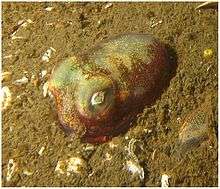Rossia pacifica
| Rossia pacifica | |
|---|---|
 | |
| Scientific classification | |
| Kingdom: | Animalia |
| Phylum: | Mollusca |
| Class: | Cephalopoda |
| Order: | Sepiolida |
| Family: | Sepiolidae |
| Subfamily: | Rossiinae |
| Genus: | Rossia |
| Species: | R. pacifica |
| Binomial name | |
| Rossia pacifica S. S. Berry, 1911[1] | |
Rossia pacifica, also known as the stubby squid, is a species of bobtail squid native to the northern Pacific Ocean. Seen in winter on sandy slopes away from strong currents in moderately shallow water, it moves in summer to deeper water where it breeds. The female cements the egg capsules under a stone or in some other concealed location, and both male and female die soon after breeding.
Subspecies
Two subspecies are recognised: - [1]
- Rossia pacifica diegensis S. S. Berry, 1912
- Rossia pacifica pacifica S. S. Berry, 1911
Description

The stubby squid is a small species growing to a maximum mantle length of about 5 cm (2.0 in) and a total length of 11 cm (4.3 in), with females being larger than males. The head bears eight short arms, a pair of retractable tentacles and two large eyes. The first pair of arms is shorter than the others and the third pair the longest. The arms are circular in cross-section and each bears up to four rows of suckers on the middle section and two rows elsewhere. In the male the tips of the first pair of arms are hypercotyli, secondary reproductive structures which are modified for handling spermatophores (bundles of sperm). The tentacles have club-shaped tips with suckers and retract into pits in the head. They can be as long as the body when fully extended. The mantle (body) is not fused to the head and is flattened dorso-ventrally and rounded at the back. It does not contain the cuttlefish bone typical of cuttlefish in the family Sepiidae. There are two large semi-circular fins with wide bases on either side of the mantle. The upper surface of this bobtail squid is normally a reddish-brown colour with a scattering of small brown or yellowish spots, but can change to greyish-green when the animal is startled.[2][3]
Distribution and habitat
The stubby squid is native to the northern Pacific Ocean. Its range extends from Korea, Japan and the Bering Sea to the western coast of North America, as far south as California. Its depth range is 20 to 1,350 m (66 to 4,429 ft). In Puget Sound it is seen in winter in regions of sloping muddy sand away from strong currents at less than 300 m (984 ft) but moves into deeper water in the summer.[2]
Behaviour
The stubby squid usually rests on the seabed and moves around, either by undulations of its fins or by expelling a jet of water from its body cavity through a moveable funnel just below the head. When disturbed, it can leave behind a thick blob of black ink as it speeds away by jet propulsion. It is nocturnal and spends the day semi-buried in soft sediment on the seabed. To submerge itself, it directs a stream of water at the sand to create a funnel-shaped depression, then it settles in the hollow and scoops sand over itself with a pair of arms, just leaving the eyes exposed.[2] While immobile, it folds its arms under its head.[3] It feeds mostly on shrimps, but also consumes small crabs, opossum shrimps, fish and other cephalopods.[3]
Breeding takes place in late summer and autumn in deep water. The female deposits up to fifty eggs in small groups, attaching them to the underside of stones, clams or seaweeds. The capsules are creamy-white and about 1 cm (0.4 in) in diameter, hard and durable. They take four to nine months to hatch, and the juveniles that emerge are miniature versions of the adults. The mature male and female die soon after breeding, having lived for about two years.[2]
References
- 1 2 Rosenberg, Gary (2013). "Rossia pacifica S. S. Berry, 1911". World Register of Marine Species. Retrieved 2014-03-22.
- 1 2 3 4 Anderson, Roland C. "Rossia pacifica, Stubby squid". The Cephalopod Page. Retrieved 2014-03-22.
- 1 2 3 Dyer, Anna (2002). "Rossia pacifica (Berry, 1911)". Invertebrates of the Salish Sea. Walla Walla University. Retrieved 2014-03-22.